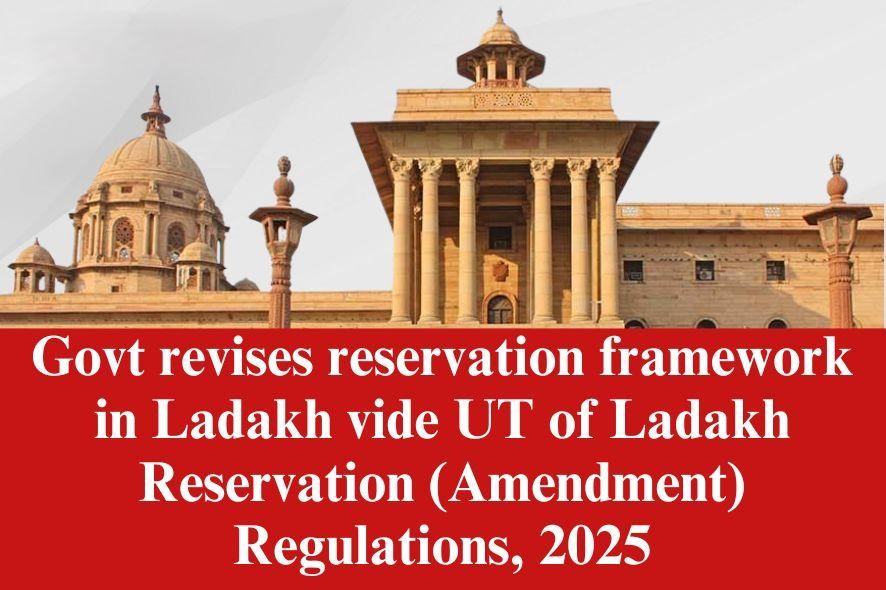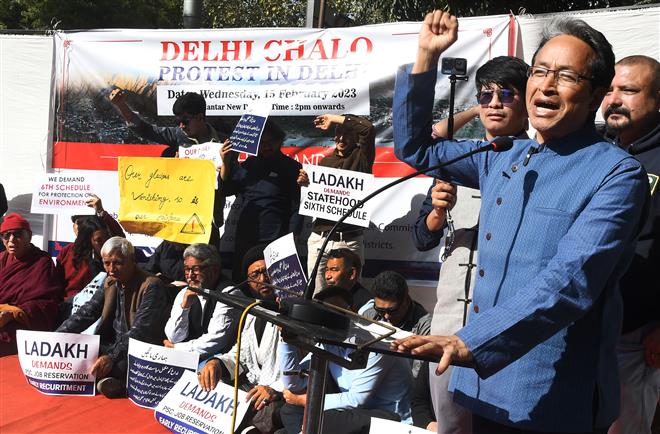Ladakh Breaks Ground: 80% Reservation for STs Under New Local Jobs Policy
By: Javid Amin | Srinagar | 30 June 2025
In a landmark decision that is set to transform the socio-political and economic landscape of the Union Territory of Ladakh, the administration has officially notified the Ladakh Reservation (Amendment) Rules, 2025. The most striking feature of this policy reform is the allocation of 80% reservation in direct recruitment to Scheduled Tribes (STs), reaffirming the region’s commitment to safeguarding the rights and representation of its indigenous population.
Along with the announcement came another powerful declaration: jobs in Ladakh are now reserved for locals only, making it one of the most protectionist employment frameworks in India today.
This sweeping reform is being hailed as an example of bold leadership and political resolve—a far cry from the usual bickering that plagues regional politics elsewhere.
Policy Backed by Law: What the Notification Covers
The rules have been notified under Section 23 of the Jammu and Kashmir Reservation Act, 2004, as amended by the UT of Ladakh Reservation (Amendment) Regulation, 2025.
The revised rules were drafted and finalized by the Social and Tribal Welfare Department in coordination with the General Administrative Department (GAD) of Ladakh, ensuring that every legal and policy requirement was met with thorough scrutiny.
Breakdown of the New Reservation Structure
Under Rule 4 of the amended notification, reservation in direct recruitment has been structured as follows:
- Scheduled Tribes (ST): 80%
- Residents of Areas Adjoining the Actual Line of Control (ALC): 4%
- Scheduled Castes (SC): 1%
- Economically Weaker Sections (EWS): 10%
- Unreserved/General (UR): 5%
Additionally, horizontal reservations include:
- Ex-Servicemen: 6%
- Persons with Benchmark Disabilities (PwBD): 4%, subdivided according to the Rights of Persons with Disabilities Act, 2016.
Reservation in Promotions: Prioritizing Inclusion at All Levels
Under Rule 9, the reservation in promotions is structured as:
- STs: 84%
- SCs: 1%
This reflects the administration’s recognition of the need to retain and promote local talent through a structured pathway of professional growth, ensuring tribal representation not only at the entry level but also in senior positions.
Mapping the ALC: Villages Along the LoC and LAC Get Benefits
A separate notification also defines and identifies Areas Adjoining the Actual Line of Control (ALC):
- Leh District: 18 revenue villages along the Line of Control (LoC) and Line of Actual Control (LAC)
- Kargil District: 34 revenue villages along the LoC
Residents from these notified areas are now officially eligible for the 4% ALC reservation, bringing clarity and access to those living in some of the UT’s most geopolitically sensitive zones.
Local Jobs for Locals: A Long-Awaited Demand Fulfilled
One of the most powerful elements of this policy is its clear stance: only local residents of Ladakh are eligible for government jobs in the UT.
This directly addresses long-standing demands from Ladakhi youth, who have protested for over four years calling for job security, constitutional safeguards, and cultural preservation.
The new rules are being hailed as a watershed moment in Ladakh’s modern history—a manifestation of self-determination and policy ownership by and for the people of the region.
Strongest Land Laws in India: Ladakh Leads the Way
Besides job reservations, the Ladakh administration has simultaneously tightened land laws, reportedly introducing the most restrictive and protective land ownership rules in India.
This legal framework ensures that:
- Non-residents cannot purchase agricultural or tribal land
- Land transfers are strictly monitored
- Customary rights are preserved for tribal communities
Together with the reservation policy, this creates a dual protection layer safeguarding Ladakh’s demographic, economic, and cultural integrity.
Political Will vs Political Stagnation
Observers have praised Ladakh’s leadership for showing “spine and vision” in negotiating this historic framework.
Unlike other regions where political actors are often caught in the loop of power games and coalition bickering, Ladakh has shown that with cohesion and clarity, it is possible to extract a “proper deal for generations to come.”
A Signal to the Centre and a Blueprint for Other UTs
The move is not just an administrative development—it is a political statement. It sends a message to the Centre, to lawmakers, and to other Union Territories that meaningful autonomy, when backed by legislative teeth, can reshape regional aspirations.
It also strengthens Ladakh’s claim for:
- Statehood
- Sixth Schedule inclusion
- Cultural and linguistic preservation
The reservation rules lay a robust groundwork for these larger demands.
Bottom-Line: A New Dawn for Ladakh’s Future
The Ladakh Reservation (Amendment) Rules, 2025 are more than a notification in a gazette—they are a vision statement for a resilient, self-governed, and forward-looking Ladakh. With its youth empowered, its land protected, and its jobs secured, the UT is poised for inclusive development that honors tradition while embracing progress.
The rest of India is watching. And perhaps, learning.


